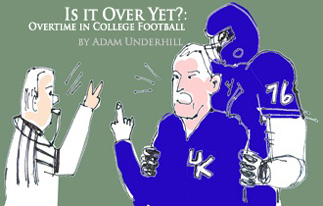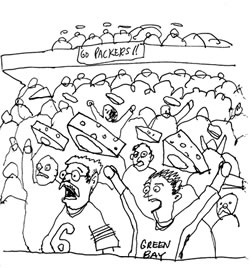Is it Over Yet?: Overtime in College Football
27.11.07
 After scoring a go-ahead touchdown in the third overtime period of the Arkansas-Louisiana State football game on November 23, the Razorbacks eschewed the extra point try, and went for two instead. It was a perilous decision: Miss the two-point conversion, and LSU could win the game with a touchdown and extra point. As we watched, my brother Brett (a.k.a. “Porkchopbob”) remarked, “that’s pretty ballsy.”
After scoring a go-ahead touchdown in the third overtime period of the Arkansas-Louisiana State football game on November 23, the Razorbacks eschewed the extra point try, and went for two instead. It was a perilous decision: Miss the two-point conversion, and LSU could win the game with a touchdown and extra point. As we watched, my brother Brett (a.k.a. “Porkchopbob”) remarked, “that’s pretty ballsy.”
Not that ballsy. Arkansas didn’t eschew the easy one point try; it was forced to go for two. If a college football game reaches a third overtime period, teams MUST go for the two-point conversion after a touchdown. This is one of many idiosyncrasies that makes college overtime different from its professional, sudden death brethren. And it’s a big part of the reason why college football overtime sucks.
The NFL has long been sneered at by fans of NCAA football as a stodgier and less exciting form of football. Offenses are complex and unchanging, players tend to be spoiled and complacent, and the stadium atmosphere on game day can feel as controlled and contrived as a political convention. By comparison, the palpable urgency and electricity surrounding an amateur (ok, semi-pro) college game is like the difference between watching a concert movie and actually watching a live concert. But if there’s one area where the pros have college beat (and in my opinion, there are plenty), it’s overtime.
Since 1974, NFL games that go into overtime are given one 15-minute extra period to avoid a tie, and whichever team scores first wins. That’s it. A coin flip determines the possession, and the teams duke it out. It’s a beautiful part of sports: One interception returned for a touchdown doesn’t just kill a drive, it kills the game. One 54-yard field goal made or missed suddenly delivers a win for one team or prime field position for the other to march for a score. If you want a great example, check out highlights of the Green Bay Packers’ 2004 overtime win over Seattle. Seahawks quarterback Matt Hasslebeck, upon winning the coin flip, scared the cheese off the heads of the Lambeau Field crowd when he brashly announced “we’ll take the ball, and we’re gonna score.” He then promptly threw an interception to cornerback Al Harris, who returned it for the game-winning touchdown.
Harris’ raucous game-closer could not happen in college football. Interceptions (as well as blocked field goal attempts) are dead balls; possession is turned over to the other team. This is because college overtime isn’t a timed period at all. Rather, the game becomes something like baseball’s extra innings, in which each team has a chance to score. With no clock governing the game, college football overtime can, in theory, go on forever. (All too often it seems to.)
 “Extra innings” would not be so bad were it not for the fact that the game suddenly resembles nothing like what passed in regulation. Since the ball is arbitrarily spotted for each team at the 25-yard-line, special teams (kickoffs, punts) are rendered nearly irrelevant. As noted above, an interception can’t be returned for a score; defenses capable of scoring thus are only useful for keeping the other team out of the end zone. One and a half of the “three phases” of football are no longer part of the game in overtime.
“Extra innings” would not be so bad were it not for the fact that the game suddenly resembles nothing like what passed in regulation. Since the ball is arbitrarily spotted for each team at the 25-yard-line, special teams (kickoffs, punts) are rendered nearly irrelevant. As noted above, an interception can’t be returned for a score; defenses capable of scoring thus are only useful for keeping the other team out of the end zone. One and a half of the “three phases” of football are no longer part of the game in overtime.
The result is a seemingly endless trading of touchdowns until one team finally falters. Some would argue that a team with a superior defense would have an advantage. This would be true but for the fact that it is a lot more difficult to stop a 25-yard scoring drive than, say, an 80-yard march. And the absurdly high scores of overtime games in college bespeak this fact: Arkansas upset LSU 50-48, and the following day Tennessee outlasted Kentucky 52-50. These were games tied at 28 and 31, respectively.
Note the two-point margin of victory in both games. I explained before that the NCAA mandates that teams go for two starting with the third overtime. Why? I can only surmise that the NCAA itself realizes that without this tweak, a college football game might outlast the entire season. By forcing teams to attempt the riskier two-point try after a touchdown, the NCAA is forcing the games to end sooner than later. It’s like Major League Baseball saying that a runner can only stop on second and home in extra innings. The rules themselves are an open admission that no one wants to sit around and watch this forever.
These offensive orgies also deliver pumped-up statistics that in no way tell the game story. You’d probably be floored if you heard Tennessee’s Eric Ainge threw seven scoring strikes on Saturday, until you found out that three of them were in overtime on drives that all began on the 25. The yards and scores that pile up are great for fantasy leagues. For those of us who enjoy a good football game, it’s about as competitive as watching your kids rack up marbles in Hungry Hungry Hippos.
I understand that college football should differ from the pros, and some of its rules are more sensible (the 15-yard pass interference penalty, for one). And no fan whose team has BCS hopes on the line wants to see a game end in an ignominious tie––what do you do with that? But college football’s overtime robs the fans and players of the many layers that make football great: Long kickoffs, kickoff returns for touchdowns, interception returns, field goal attempts that gamble with field position. These are the facets of football that make it feel like more than just a series of easy scores, but a game of strategy, stamina, and never knowing which way the ball is going to bounce. That’s the way it is in regulation. Why should overtime be any different?